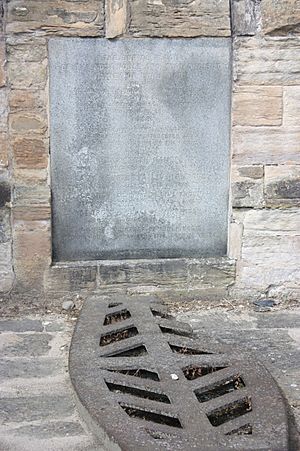George Livingston, 3rd Earl of Linlithgow facts for kids
Quick facts for kids
The Earl of Linlithgow
|
|
|---|---|
| Personal details | |
| Born |
George Livingston
July 1616 |
| Died | 1 February 1690 (aged 73) |
| Spouses |
Lady Elizabeth Lyon
(m. 1650, died)Agnes Wauchope Scott
(m. 1677) |
| Children | George Livingston, 4th Earl of Linlithgow Alexander Livingston, 3rd Earl of Callendar Lady Henrietta Livingston |
| Parents | Alexander Livingston, 2nd Earl of Linlithgow Lady Elizabeth Gordon |
| Relatives | James Livingston, 5th Earl of Linlithgow (grandson) |
George Livingston (July 1616 – 1 February 1690) was an important military officer and the third Earl of Linlithgow. An Earl is a noble title, a bit like a duke or a baron. He was also a Privy Councillor, meaning he was an advisor to the King.
Early Life and Family

George Livingston was born in July 1616. He was the oldest son of Alexander Livingston, 2nd Earl of Linlithgow. His mother was Lady Elizabeth Gordon. Sadly, she died shortly after George was born.
George had a sister named Lady Margaret Livingston. She married Sir Thomas Nicholson, and later Sir George Stirling, and then Sir John Stirling.
His grandparents were Alexander Livingstone, 1st Earl of Linlithgow and Lady Helen Hay. His uncle was James Livingston, 1st Earl of Callendar.
Military and Political Career
George Livingston took over as the manager and guardian of Linlithgow Palace in 1642. This happened when his father stepped down from the role. When his father passed away in 1648, George became the 3rd Earl of Linlithgow.
In 1650, George was allowed to join the Scottish Parliament. He was made a colonel of a horse regiment (a cavalry unit) in Perth. He also served as a representative for Perthshire in Oliver Cromwell's parliament from 1654 to 1655.
When the King returned to power in Britain (this event is called the Restoration), George was given important roles. He became a colonel in the Scots Regiment of Foot Guards. This was a very important military group. He also became a Privy Councillor, which meant he advised the King on important matters.
In 1677, George was made a major-general of the forces in Scotland. His main job was to keep order against certain religious groups known as Covenanters. These groups sometimes held meetings without permission.
After a battle at Battle of Drumclog in 1679, where his forces faced a defeat, Linlithgow was unsure what to do. He pulled his troops back to Edinburgh to wait for help from England. When English soldiers arrived, the overall command was given to Monmouth.
Later, in 1684, George was appointed as a justice-general. This was a high legal position. However, he lost this job during the Glorious Revolution when King William III came to power. George Livingston died before a plot he was connected with, called the Montgomery plot, was fully revealed.
Personal Life
George Livingston married Lady Elizabeth Lyon on July 30, 1650. She was the widow of the 2nd Earl of Kinghorne. Together, they had three children:
- George Livingston, 4th Earl of Linlithgow (who died in 1695).
- Alexander Livingston, 3rd Earl of Callendar (who died in 1692).
- Lady Henrietta Livingston.
After his first wife passed away, George married Agnes Wauchope Scott in June 1677. Agnes was a widow and the daughter of George Wauchope.
George Livingston died on February 1, 1690. He was buried in a family tomb at St Michael's Church in Linlithgow, which is west of Edinburgh.
His Descendants
After a battle in 1689, George's son-in-law and both of his sons were accused of not supporting the new King, King William III. They were arrested and held in Edinburgh Castle. They were only released after they promised to be loyal to King William III.
Through his second son, Alexander, George Livingston became the grandfather of James Livingston, 5th Earl of Linlithgow. His eldest son, George, did not have any children.

